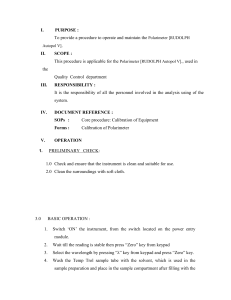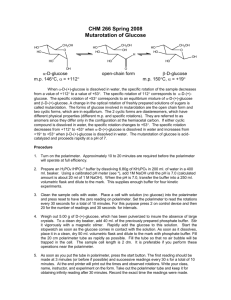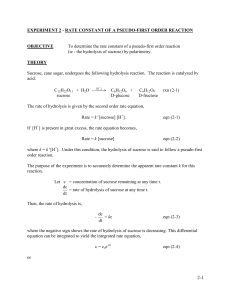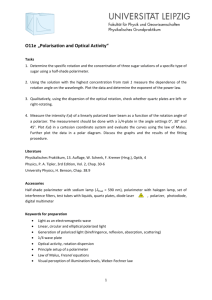IS --- Reaction Rate of the Inversion of Sucrose
advertisement
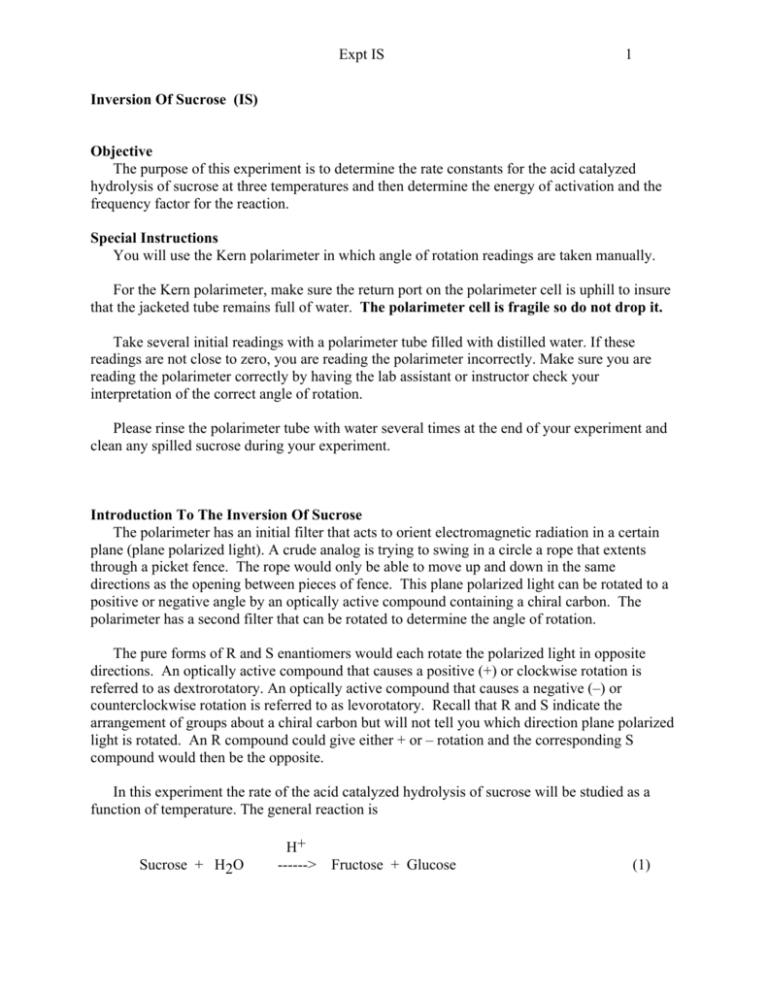
Expt IS 1 Inversion Of Sucrose (IS) Objective The purpose of this experiment is to determine the rate constants for the acid catalyzed hydrolysis of sucrose at three temperatures and then determine the energy of activation and the frequency factor for the reaction. Special Instructions You will use the Kern polarimeter in which angle of rotation readings are taken manually. For the Kern polarimeter, make sure the return port on the polarimeter cell is uphill to insure that the jacketed tube remains full of water. The polarimeter cell is fragile so do not drop it. Take several initial readings with a polarimeter tube filled with distilled water. If these readings are not close to zero, you are reading the polarimeter incorrectly. Make sure you are reading the polarimeter correctly by having the lab assistant or instructor check your interpretation of the correct angle of rotation. Please rinse the polarimeter tube with water several times at the end of your experiment and clean any spilled sucrose during your experiment. Introduction To The Inversion Of Sucrose The polarimeter has an initial filter that acts to orient electromagnetic radiation in a certain plane (plane polarized light). A crude analog is trying to swing in a circle a rope that extents through a picket fence. The rope would only be able to move up and down in the same directions as the opening between pieces of fence. This plane polarized light can be rotated to a positive or negative angle by an optically active compound containing a chiral carbon. The polarimeter has a second filter that can be rotated to determine the angle of rotation. The pure forms of R and S enantiomers would each rotate the polarized light in opposite directions. An optically active compound that causes a positive (+) or clockwise rotation is referred to as dextrorotatory. An optically active compound that causes a negative (–) or counterclockwise rotation is referred to as levorotatory. Recall that R and S indicate the arrangement of groups about a chiral carbon but will not tell you which direction plane polarized light is rotated. An R compound could give either + or – rotation and the corresponding S compound would then be the opposite. In this experiment the rate of the acid catalyzed hydrolysis of sucrose will be studied as a function of temperature. The general reaction is Sucrose + H2O H+ ------> Fructose + Glucose (1) Expt IS 2 The reactant and the two products, invert sugar, are optically active and their aqueous solutions rotate polarized light. The specific rotation of sucrose is +66.4 degrees and of invert sugar is – 19.7 degrees. The specific rotation is defined as the degrees rotation per gram of solute per cubic centimeter of solution per 10 cm path length. The rotation changes from clockwise to counterclockwise as the reaction proceeds and this process can be monitored with a polarimeter. The change in the angle of rotation of plane polarized light going through sucrose in the presence of yeast was observed in 1832. In the presence of yeast, the reaction is catalyzed by an enzyme that breaks the sucrose into its component sugars of fructose and glucose. The enzyme reaction has a significantly lowered energy of activation and so the reaction is greatly accelerated. While not as dramatic, the presence of acid can also speed up the reaction. In this experiment, you will study the acid catalyzed reaction. Theory The reaction is first order in sucrose and in hydrogen ion concentration and is thought to proceed through the reversible formation of a protonated sucrose complex which may be represented as k1 k3 (2) S + H2O+ <=====> S-H3O+ -----> F + G + H+ k2 where S, F, and G are abreviations for the sugars involved. Application of the steady state approximation (this assumes that the concentration of the activated complex is small and constant) to this mechanism gives d[S-H3O+]/dt = 0 = k1[S][H3O+] – k2[S-H3O+] – k3[S-H3O+] (3) Solving for [S-H3O+] and substituting for d[products]/dt = – d[S]/dt = k3[S-H3O+] (4) gives the following rate equation, – d[S]/dt = k[S][H3O+] (5) where k = (k1)(k3)/(k2+k3). Since the hydronium ion concentration remains constant except for the very small amount involved in the activated complex, one can write – d[S]/dt = k´[S] (6) k´ = k[H+] (7) where Expt IS 3 or k = k´/[H+] (8) Integration of Eq. (6) gives ln[S/So] = – k´t (9) where t is the time and k is the rate constant. The angle, Q, by which plane polarized light is rotated by the reaction mixture varies linearly with the concentration of sucrose. This follows from the linear dependence of Q on the concentrations of the three sugars where Q = a[S] + b[F] + c[G] (10) and a, b, and c are functions of the polarimeter cell length, the specific rotation of the particular sugar, and the concentration units chosen. Since, as S is decreased F and G are formed, then stoichiometry requires [F] = [G] = [So] – [S] (11) where [So] is the initial concentration of S. Combining the two previous equations gives Q = (a – b– c)[S] + (b+c)[So] (12) and thus Q is linear in [S]. After a sufficient length of time for the reaction to go to completion one can define a value of Q such that Qz = (b + c) [So] (13) and using the proportionality [S] = Q – Qz the integrated rate equation becomes – k´t = ln( [Q – Qz]/[Qo– Qz] ) (14) ln [Q – Qz] = – k´t + ln [Qo – Qz] (15) or Based on the above equation, a plot of ln [Q – Qz] versus the time, t, should yield a straight line with – k´ as the slope. Note that the value of Qo is not needed and thus the point t=0 is arbitrary and may be taken at the point in time at which the measurement of Q commenced. This is a general property of all first order reactions. If the angles of rotation, Q, of the sugar mixture are observed at successive times, t, and the final equilibrium value of the angle of rotation, Qz, is available after the reaction is complete (the angle of rotation is no longer changing), then a plot of ln [Q – Qz] versus t gives the slope of –k’. Then the overall rate constant, k, may be obtained from Eq. (8). Expt IS 4 The temperature dependence of the rate can be represented by the empirical Arrhenius equation, k = A e – Ea/RT (16) where k is the rate constant at a temperature T(K), A is the frequency factor (s–1), R is the gas constant expressed in energy units, and Ea is the energy of activation for the reaction. Taking the natural logarithm of both sides gives ln k = ln A + (– Ea/R)(1/T) (17) where R is the appropriate gas constant, T is the temperature in degrees kelvin, A is the frequency factor, and Ea is the energy of activation. If k values are available at vrious temperatures then a plot of ln k (y axis) versus 1/T (x axis) will be a straight line with an intercept of ln A at 1/T=0 and a slope of – Ea/R. Instructions The sample is contained in a 10 cm polarimeter tube (for the Kern polarimeter) which fits into the trough in the polarimeter. A jacketed tube is used for exact temperature control. Light from a lamp passes through a split field polarizer, then the polarimeter tube, and finally a rotatable analyzer polarizer. The analyzer is adjusted to match the three sections of the optical field at the lighter extreme. The angle of rotation is read from a scale on the analyzer and should be about 0 with an empty tube. The three sections of the optical field may be brought into sharp focus by moving the eyepiece backwards and forwards. Runs are to be made in 0.500 M HCl at 35, 45, and 50 oC. As with all first order reactions the initial concentration of the reactant need not be accurately known. However, the hydrogen ion concentration must be accurate. Dissolve about 20 grams of sucrose in water and dilute to 50 mL. Use this same sucrose solution for all three runs. Have the jacketed polarimeter tube connected to the circulator and set at the desired temperature. Now thoroughly mix exactly 10.00 mL of 1.00 M HCl and 10.00 mL of sucrose solution, stir to mix, and after it is well mixed then fill the tube. Make sure you mix your 10ml of acid and 10ml of sucrose well in a beaker prior to adding the mixture to the polarimeter tube. Start the timer as soon as the two solutions are completely together in the beaker. Stir vigorously for about 30 seconds then add to polarimeter tube. The concentration of HCl in the sucrose and acid solution is now 0.500M. After pouring the mixture into the polarimeter tube prepare to make your first reading. Take your first reading when the timer is at 2 minutes. Follow the angle of rotation with time at a temperature of 35oC and then discard the mixture in the polarimeter tube. Repeat the procedure again at 45oC and 50oC. Note that you must use the same initial sucrose concentration for all runs, but you must pipet a new 10.00 mL sample of sucrose solution and 10.00mL of acid to start each new run. Expt IS 5 When finished with the temperature run at 35, discard the reacted solution and again take 10mL of sucrose solution and 10mL of HCl for run at 45oC and again at 50oC. Estimate the angle to the nearest 0.1 degree. If during the course of your experiment you observe the angle of rotation to be greater than +30 degrees or less than -10 degrees, then you are reading the polarimeter incorrectly. When adding solution to the polarimeter cell carefully tilt the cell back and forth to remove any air bubbles. A blurred image that cannot be focused by moving the eyepiece in and out is an indication that an air bubble is present. Take readings every 2 minutes up to a max of 20 minutes total at 35oC, every 1 minute for a maximum of 10 minutes at 45oC, and every 1 minute for a maximum of 8 minutes at 50oC. At 50oC if values of angle rotation stop changing with time then the solution may have reached its equilibrium value and you can ignore any repeated values. In each case your first reading will be at time t = 2minutes. Previous angle measurements using the Kern Polarimeter indicate that Qz equals –5.3 at 35oC, –4.5 at 45oC and –3.8 at 50oC. You will use these values in your calculations instead of determining for yourself because it would take some time for the reactions to reach their final equilibrium value. To measure Qz, you would have to let each reaction continue until the rotation readings were no longer changing. This process could take several hours at the lowest temperature. Analysis Prepare three data tables with columns of t, Q, Q – Qz, and ln(Q – Qz). One table is needed for each temperature run. Plot ln (Q – Qz) versus time to get k' values and then calculate the specific rate constant, k, at each temperature k(35), k(45), and k(50) from knowledge of the acid concentration. Recall that k = k´/[H+]. Note that you will calculate k', k, and lnk at 35, 45, and 50oC. Present your results in a table with columns labeled T(K), 1/T (K-1), k' (s-1), k(s-1), and ln k. Note that an error in Q will affect the points toward the end of a run most severely, while a lag in the temperature equilibrium will affect the first points. Report values of k (s-1) at the three temperatures. Note that if you plot the time in minutes then your value of k’ and k will be in min–1 and must be converted to s–1 when you make this conversion consider that (1/s) = (1/min)(min/60s). Report values of ln A, A, and energy of activation Ea (kJ/mol). Your report should include a total of four linear plots. It is difficult to get extremely accurate A values because of long extrapolation and then conversion from ln A to A tends to magnify any error in extrapolation. However, the experimental Ea value generally agrees with accepted value. Expt IS 6 Plot ln k versus the reciprocal of the absolute temperature to get the energy of activation and the frequency factor. Make sure the frequency factor A is in s-1 units to compare to literature values and recall that Ea should be in units kJ/mol.
